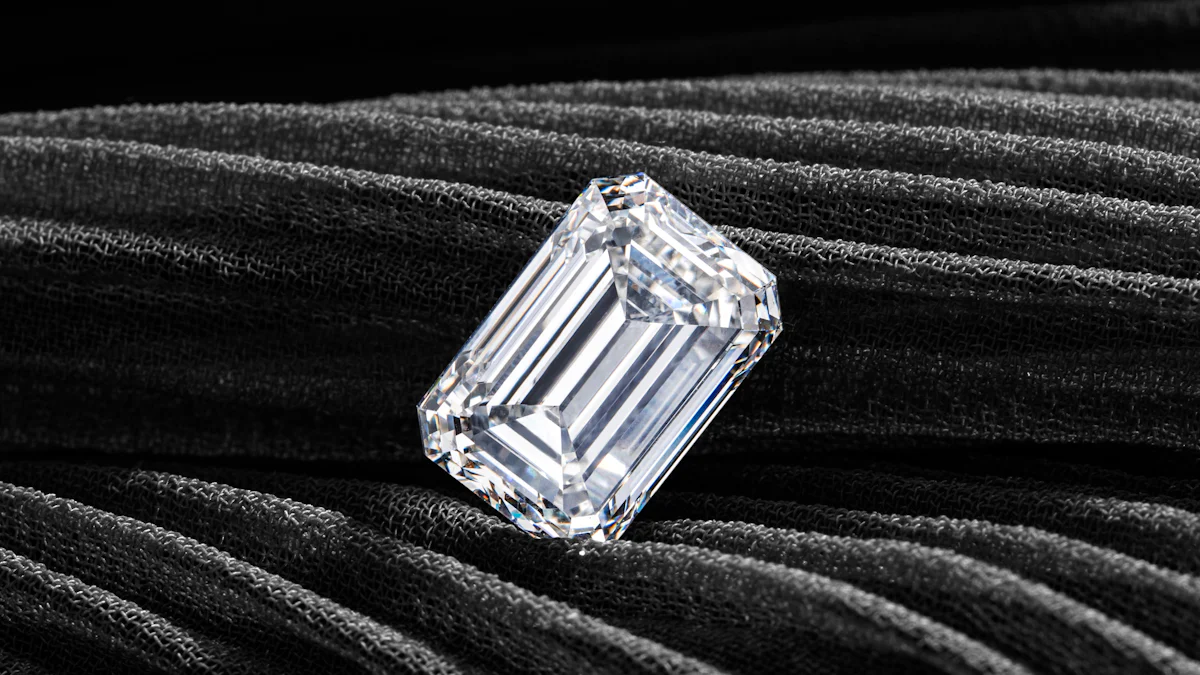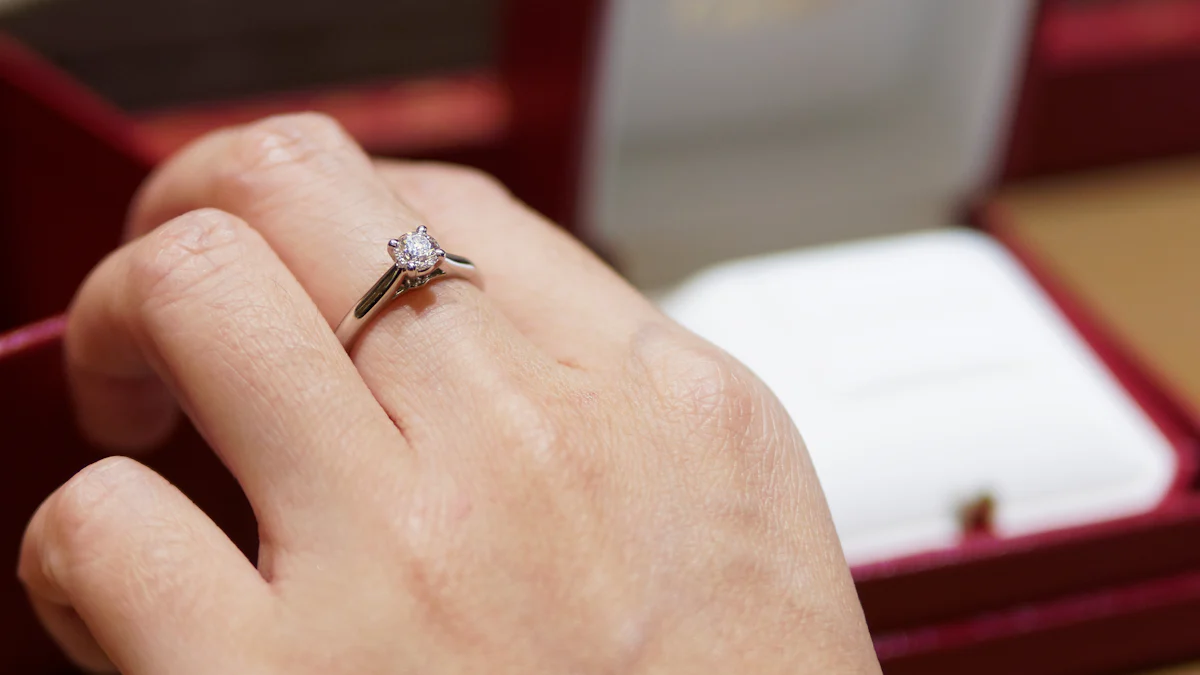What SI Diamond Clarity Means for Buyers

SI diamond clarity represents a crucial aspect of diamond evaluation, especially for buyers like you. It stands for "Slightly Included," indicating that these diamonds contain tiny inclusions. These inclusions are often not visible to the naked eye, making SI diamonds a popular choice for those seeking a balance between quality and affordability. Understanding clarity is essential when purchasing diamonds because it directly affects the stone's appearance, price, and desirability. By grasping the nuances of SI clarity, you can make informed decisions and find the perfect diamond that meets your needs and budget.
Key Takeaways
- SI diamonds, or 'Slightly Included' diamonds, offer a balance between quality and affordability, making them a popular choice for budget-conscious buyers.
- Many SI diamonds appear eye-clean, especially those graded as SI1, meaning their inclusions are not visible to the naked eye, enhancing their visual appeal.
- Understanding the grading process and the visibility of inclusions can help you appreciate the value of SI diamonds and make informed purchasing decisions.
- When comparing SI diamonds to higher clarity grades like VS, SI diamonds provide a more cost-effective option without sacrificing beauty.
- To ensure you select the best SI diamond, work with a gemologist and examine the diamond under magnification to assess inclusions and overall quality.
- Consider the diamond's cut, color, and carat weight, as these factors significantly influence its appearance and value.
- While SI diamonds may have lower resale value compared to higher clarity grades, they still hold value due to their appealing balance of quality and cost.
Understanding SI Diamond Clarity
Definition of SI Clarity
When you explore the world of diamonds, understanding clarity becomes essential. SI clarity, which stands for "Slightly Included," refers to diamonds that contain small inclusions. These inclusions are typically visible only under 10x magnification by a skilled grader. In practice, you might notice these inclusions if you examine the diamond closely, especially in the case of SI2 diamonds. These inclusions can range from tiny specks to more noticeable features, affecting the diamond's visual appeal. Despite these inclusions, many SI diamonds appear eye-clean, meaning their imperfections are not visible to the naked eye. This makes them a popular choice for those seeking a balance between beauty and cost.
How SI Clarity is Determined
The clarity of a diamond, including those with SI grades, is assessed using a standardized grading system. The Gemological Institute of America (GIA) is renowned for its rigorous grading reports. To determine SI clarity, gemologists examine the diamond under 10x magnification. They assess the size, number, and location of inclusions. SI1 diamonds often have inclusions that are less visible compared to SI2 diamonds, which may have more prominent inclusions. The grading process involves evaluating how these inclusions impact the diamond's overall appearance and brilliance. By understanding this process, you can better appreciate the value and beauty of SI diamonds.
Impact of SI Clarity on Diamond Appearance

Visibility of Inclusions
When you examine SI diamonds, the visibility of inclusions becomes a key factor. These diamonds, classified as "Slightly Included," contain small imperfections. Under 10x magnification, these inclusions become apparent. However, to the naked eye, many SI diamonds appear eye-clean, especially those with an SI1 grade. This means that while inclusions exist, they often do not detract from the diamond's beauty. Larger diamonds may reveal inclusions more easily than smaller ones, even within the same clarity grade. Understanding this can help you appreciate the balance between clarity and visual appeal in SI diamonds.
Comparison with Other Clarity Grades
VS (Very Slightly Included) vs. SI
When comparing SI diamonds to VS (Very Slightly Included) diamonds, clarity differences emerge. VS diamonds offer a higher clarity level, with fewer and less visible inclusions. This makes them more desirable for those prioritizing clarity. However, SI diamonds provide a cost-effective alternative. They maintain a beautiful appearance without the premium price tag of VS diamonds. While inclusions in SI diamonds might be visible upon close inspection, they often remain hidden to the casual observer.
I (Included) vs. SI
Comparing SI diamonds to I (Included) diamonds highlights the advantages of SI clarity. I diamonds have more noticeable inclusions, which can affect their overall appearance. In contrast, SI diamonds strike a balance between clarity and affordability. They offer a cleaner look than I diamonds, making them a popular choice for buyers seeking value. By choosing SI diamonds, you can enjoy a visually appealing stone without compromising on quality or budget.
Influence of SI Clarity on Diamond Value
Pricing Considerations
When you consider purchasing SI diamonds, understanding their pricing is crucial. These diamonds offer a balance between quality and cost, making them an attractive option for many buyers. The price of an SI diamond depends on several factors, including its size, color, and whether it is natural or lab-grown. For instance, a round, H color, SI clarity, 1-carat natural diamond might cost around $4,500. In contrast, the same diamond in a lab-grown variant could be approximately $1,500. This significant price difference highlights the affordability of lab-grown diamonds while maintaining the appeal of SI clarity.
Resale Value Implications
The resale value of SI diamonds can vary based on their clarity and other characteristics. While SI diamonds are more affordable initially, their resale value might not be as high as diamonds with higher clarity grades. However, they still hold value due to their balance of appearance and cost. When you decide to resell an SI diamond, factors such as market demand, the diamond's condition, and its certification will influence its resale price. Understanding these aspects can help you make informed decisions about investing in SI diamonds and their potential future value.
Pros and Cons of Choosing SI Diamonds
Advantages of SI Diamonds
When you consider purchasing SI diamonds, several advantages stand out. First, these diamonds offer a balance between affordability and appearance. You can enjoy the beauty of a diamond without breaking the bank. An SI1 diamond, for instance, often appears eye-clean, meaning its inclusions are not visible to the naked eye. This makes it nearly indistinguishable from higher clarity grades like VS diamonds, but at a more affordable price.
Moreover, SI diamonds provide excellent value for budget-conscious buyers. You can find a diamond that meets your aesthetic preferences while staying within your financial limits. The combination of quality and cost-effectiveness makes SI diamonds an ideal choice for those seeking a balance between quality and price.
Potential Drawbacks
Despite their benefits, SI diamonds come with potential drawbacks. The primary concern is the visibility of inclusions. While many SI1 diamonds appear eye-clean, SI2 diamonds may have more noticeable imperfections. These inclusions can affect the diamond's brilliance and overall appeal, especially in larger stones where flaws are more apparent.
Additionally, the resale value of SI diamonds might not be as high as diamonds with higher clarity grades. If you plan to resell your diamond in the future, consider how its clarity might impact its market value. Understanding these potential drawbacks will help you make an informed decision when choosing SI diamonds.
Recommendations for Buyers
When to Choose SI Diamonds
Choosing SI diamonds can be a smart decision for several reasons. If you prioritize a balance between quality and affordability, SI diamonds offer an excellent option. These diamonds often appear eye-clean, especially those with an SI1 grade, making them visually appealing without the high cost of higher clarity grades. You might consider SI diamonds when you want a larger stone without exceeding your budget. They provide a way to enjoy the beauty of a diamond while maintaining financial prudence.
Additionally, SI diamonds are ideal if you plan to set the stone in a ring or jewelry piece where inclusions can be masked. A skilled gemologist can assist you in selecting a setting that minimizes the visibility of any inclusions. This ensures that the diamond's beauty remains the focal point.
Tips for Evaluating SI Diamonds
When evaluating SI diamonds, focus on several key aspects to ensure you make an informed purchase. First, examine the diamond under magnification to identify the size and location of inclusions. While many SI diamonds appear eye-clean, understanding the specific characteristics of the stone helps you appreciate its value.
Consider working with a gemologist who can guide you in selecting the best SI diamond. Gemologist, an expert in diamonds, suggests, "If you want to invest in SI diamond, it's best to work with a gemologist who can help you find the best stone with the fewest inclusions." This professional insight ensures you choose a diamond that meets your aesthetic and financial needs.
Furthermore, pay attention to the diamond's cut, color, and carat weight. These factors significantly influence the overall appearance and value of the diamond. A well-cut SI diamond can enhance its brilliance, making inclusions less noticeable. By considering these tips, you can confidently select an SI diamond that aligns with your preferences and budget.
Comparing SI Diamonds with Other Options

SI vs. Higher Clarity Grades
When you compare SI diamonds to higher clarity grades, such as VS (Very Slightly Included) or VVS (Very Very Slightly Included), several differences emerge. Higher clarity grades contain fewer inclusions, which are often invisible even under magnification. This results in a diamond that appears flawless to the naked eye. However, these diamonds come with a higher price tag due to their rarity and perceived perfection.
In contrast, SI diamonds offer a more affordable option. They strike a balance between cost and appearance. While they may have inclusions visible under magnification, many SI diamonds appear eye-clean, especially those graded as SI1. This means you can enjoy a visually appealing diamond without the premium cost associated with higher clarity grades.
Key Differences:
- Inclusion Visibility: Higher clarity grades have fewer visible inclusions.
- Cost: SI diamonds are more budget-friendly.
- Appearance: SI diamonds can appear eye-clean, offering great value.
SI vs. Lower Clarity Grades
Comparing SI diamonds to lower clarity grades, such as I (Included), highlights the advantages of choosing SI clarity. Diamonds in the I category have more noticeable inclusions, which can affect their overall appearance and brilliance. These inclusions are often visible to the naked eye, making them less desirable for those seeking a clean look.
SI diamonds, on the other hand, provide a cleaner appearance. They often have inclusions that are not visible without magnification, making them a popular choice for engagement rings and other jewelry. This makes SI diamonds a great option if you want a diamond that looks beautiful without the imperfections seen in lower clarity grades.
Key Differences:
- Inclusion Visibility: I diamonds have more visible inclusions.
- Appearance: SI diamonds offer a cleaner look.
- Value: SI diamonds provide a balance between clarity and cost.
By understanding these comparisons, you can make an informed decision when selecting a diamond that meets your aesthetic preferences and budget.
In summary, understanding SI diamond clarity is crucial for making informed purchasing decisions. These diamonds offer a balance between beauty and affordability, making them an attractive option for many buyers. When considering SI diamonds, focus on their visual appeal and ensure they meet your personal preferences and budget. Compare them with other clarity grades to find the best value. Always check the diamond certificate for quality assurance. By prioritizing clarity and conducting thorough research, you can confidently select a diamond that suits your needs.
FAQ
Is SI Clarity good for a diamond?
SI diamonds offer an excellent choice for buyers seeking a balance between quality and price. You can enjoy the beauty of a diamond without overspending. Understanding the characteristics of SI diamonds helps you make an informed decision. Always choose a reputable jeweler and prioritize your preferences when selecting an SI diamond that perfectly suits your style and budget.
In terms of clarity, do SI diamonds offer a balance between affordability and appearance?
Yes, SI diamonds provide a great balance between affordability and appearance. Their slight inclusions do not detract from the overall beauty and sparkle. These diamonds offer a captivating charm, making them a valuable addition to any jewelry collection. They are ideal for engagement rings and other jewelry pieces.
How can I ensure the quality of an SI diamond?
To ensure the quality of an SI diamond, work with a reputable jeweler. Examine the diamond under magnification to identify inclusions. Consider the diamond's cut, color, and carat weight. A well-cut SI diamond can enhance its brilliance, making inclusions less noticeable. Always check the diamond certificate for quality assurance.
Are SI diamonds suitable for engagement rings?
Absolutely, SI diamonds are suitable for engagement rings. They often appear eye-clean, especially those with an SI1 grade. This means their inclusions are not visible to the naked eye, maintaining the diamond's beauty. You can enjoy a visually appealing diamond without the high cost of higher clarity grades.
What should I consider when buying an SI diamond?
When buying an SI diamond, consider its size, color, and whether it is natural or lab-grown. Examine the diamond under magnification to understand its inclusions. Work with a gemologist who can guide you in selecting the best SI diamond. Pay attention to the diamond's cut, as it significantly influences its overall appearance and value.
How do SI diamonds compare to higher clarity grades?
SI diamonds offer a more affordable option compared to higher clarity grades like VS or VVS. While higher clarity grades contain fewer inclusions, SI diamonds strike a balance between cost and appearance. Many SI diamonds appear eye-clean, allowing you to enjoy a beautiful diamond without the premium cost.
Can I resell an SI diamond?
Yes, you can resell an SI diamond. However, its resale value might not be as high as diamonds with higher clarity grades. Factors such as market demand, the diamond's condition, and its certification will influence its resale price. Understanding these aspects can help you make informed decisions about investing in SI diamonds.
What are the potential drawbacks of choosing SI diamonds?
The primary concern with SI diamonds is the visibility of inclusions. While many SI1 diamonds appear eye-clean, SI2 diamonds may have more noticeable imperfections. These inclusions can affect the diamond's brilliance and overall appeal, especially in larger stones where flaws are more apparent.
How do SI diamonds compare to lower clarity grades?
SI diamonds provide a cleaner appearance compared to lower clarity grades like I (Included). Diamonds in the I category have more noticeable inclusions, which can affect their overall appearance and brilliance. SI diamonds often have inclusions that are not visible without magnification, making them a popular choice for those seeking a clean look.
What tips can help me evaluate SI diamonds?
When evaluating SI diamonds, focus on the size and location of inclusions. Work with a gemologist who can help you find the best stone with the fewest inclusions. Pay attention to the diamond's cut, color, and carat weight. These factors significantly influence the overall appearance and value of the diamond.
See Also
Exploring Different Cuts of Diamonds for Engagement Rings
Key Characteristics That Make a Diamond Ring Flawless
Essential Elements Influencing the Price of Diamond Rings

